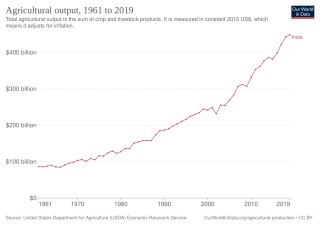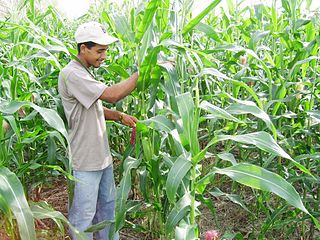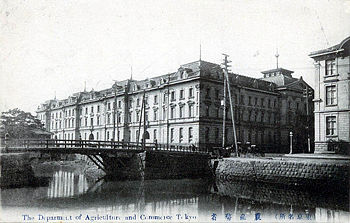Huge changes in agricultural practice were instituted under the Czechoslovak Socialist Republic. 95% of all privately owned companies were nationalized, and 95% of farms were nationalized. No one could own more than 50 hectares of land. Collectivization worked for some but not others. Larger farms were organized on 3 levels of hierarchy which actually reduced worker participation in decision making. A massive trend during the early part of the collectivization period was that younger workers left for better jobs in the cities and productivity fell. Reforms in the 1970s saw more investment and improvements began to appear gradually. There were record harvests in the 1980s.

Agriculture, forestry, and fishing form the primary sector of industry of the Japanese economy together with the Japanese mining industry, but together they account for only 1.3% of gross national product. Only 20% of Japan's land is suitable for cultivation, and the agricultural economy is highly subsidized.

Agriculture in Thailand is highly competitive, diversified and specialized and its exports are very successful internationally. Rice is the country's most important crop, with some 60 percent of Thailand's 13 million farmers growing it on almost half of Thailand's cultivated land. Thailand is a major exporter in the world rice market. Rice exports in 2014 amounted to 1.3 percent of GDP. Agricultural production as a whole accounts for an estimated 9–10.5 percent of Thai GDP. Forty percent of the population work in agriculture-related jobs. The farmland they work was valued at US$2,945/rai in 2013. Most Thai farmers own fewer than eight ha (50 rai) of land.

Agriculture in Cuba has played an important part in the economy for several hundred years. Today, it contributes less than 10% to the gross domestic product (GDP), but it employs about 20% of the working population. About 30% of the country's land is used for crop cultivation.

The history of agriculture in India dates back to the Neolithic. India ranks second worldwide in farm outputs. As per the Indian economic survey 2018, agriculture employed more than 50% of the Indian workforce and contributed 17–18% to the country's GDP.
Agriculture in Lithuania dates to the Neolithic period, about 3,000 to 1,000 BC. It has been one of Lithuania's most important occupations for many centuries.

Agriculture in South Korea is a sector of the economy of South Korea. Korean agriculture is the basic industry of the Korean economy, consisting of farming, animal husbandry, forestry and fishing. At the time of its founding, Korea was a typical agricultural country, with more than 80% of the population engaged in agricultural production. After land reform under the Lee Seung-man administration, economic revitalization under the Park Chung-hee military government and the wave of world trade liberalization that began in the 1980s, Korean agriculture has undergone dramatic changes. Through the Green Revolution, Korea became self-sufficient in rice, the staple food, in 1978, and in 1996, Korea became the first Asian country after Japan to mechanize its agriculture with fine-grained cultivation. The development of Korean agriculture has also led to the development of agriculture-related industries such as fertilizer, agricultural machinery and seed.

For millennia, agriculture has played an important role in the Chinese economy and society. By the time the People's Republic of China was established in 1949, virtually all arable land was under cultivation; irrigation and drainage systems constructed centuries earlier and intensive farming practices already produced relatively high yields. But little prime virgin land was available to support population growth and economic development. However, after a decline in production as a result of the Great Leap Forward (1958–60), agricultural reforms implemented in the 1980s increased yields and promised even greater future production from existing cultivated land.

Agriculture is one of the main industries in Taiwan. It contributes to the food security, rural development and conservation of Taiwan. Around 24% of Taiwan's land is used for farming.
Agriculture continued to be the mainstay of the economy of Haiti in the late 1980s; it employed approximately 66 percent of the labor force and accounted for about 35 percent of GDP and for 24 percent of exports in 1987. The role of agriculture in the economy has declined severely since the 1950s, when the sector employed 80 percent of the labor force, represented 50 percent of GDP, and contributed 90 percent of exports. Many factors have contributed to this decline. Some of the major ones included the continuing fragmentation of landholdings, low levels of agricultural technology, migration out of rural areas, insecure land tenure, a lack of capital investment, high commodity taxes, the low productivity of undernourished animals, plant diseases, and inadequate infrastructure. Neither the government nor the private sector invested much in rural ventures; in FY 1989 only 5 percent of the national budget went to the Ministry of Agriculture, Natural Resources, and Rural Development. As Haiti entered the 1990s, however, the main challenge to agriculture was not economic, but ecological. Extreme deforestation, soil erosion, droughts, flooding, and the ravages of other natural disasters had all led to a critical environmental situation.

Angola is a potentially rich agricultural country, with fertile soils, a favourable climate, and about 57.4 million ha of agricultural land, including more than 5.0 million ha of arable land. Before independence from Portugal in 1975, Angola had a flourishing tradition of family-based farming and was self-sufficient in all major food crops except wheat. The country exported coffee and maize, as well as crops such as sisal, bananas, tobacco and cassava. By the 1990s Angola produced less than 1% the volume of coffee it had produced in the early 1970s, while production of cotton, tobacco and sugar cane had ceased almost entirely. Poor global market prices and lack of investment have severely limited the sector since independence.

Agriculture employs the majority of Madagascar's population. Mainly involving smallholders, agriculture has seen different levels of state organisation, shifting from state control to a liberalized sector.
Uganda's favorable soil conditions and climate have contributed to the country's agricultural success. Most areas of Uganda have usually received plenty of rain. In some years, small areas of the southeast and southwest have averaged more than 150 millimeters per month. In the north, there is often a short dry season in December and January. Temperatures vary only a few degrees above or below 20 °C but are moderated by differences in altitude.

The role of agriculture in the Bolivian economy in the late 1980s expanded as the collapse of the tin industry forced the country to diversify its productive and export base. Agricultural production as a share of GDP was approximately 23 percent in 1987, compared with 30 percent in 1960 and a low of just under 17 percent in 1979. The recession of the 1980s, along with unfavorable weather conditions, particularly droughts and floods, hampered output. Agriculture employed about 46 percent of the country's labor force in 1987. Most production, with the exception of coca, focused on the domestic market and self-sufficiency in food. Agricultural exports accounted for only about 15 percent of total exports in the late 1980s, depending on weather conditions and commodity prices for agricultural goods, hydrocarbons, and minerals.

Rice production in Japan is important to the food supply in Japan, with rice being a staple part of the Japanese diet. Most people in Japan see this food as a substantial part of their daily diet.

Agriculture in Panama is an important sector of the Panamanian economy. Major agricultural products include bananas, cocoa beans, coffee, coconuts, timber, beef, chicken, shrimp, corn, potatoes, rice, soybeans, and sugar cane.
Prior to World War II, agriculture in Bulgaria was the leading sector in the Bulgarian economy. In 1939, agriculture contributed 65 percent of Net material product (NMP), and four out of every five Bulgarians were employed in agriculture. The importance and organization of Bulgarian agriculture changed drastically after the war, however. By 1958, the Bulgarian Communist Party (BCP) had collectivized a high percentage of Bulgarian farms; in the next three decades, the state used various forms of organization to improve productivity, but none succeeded. Meanwhile, private plots remained productive and often alleviated agricultural shortages during the Todor Zhivkov era.
Poland's agricultural sector is vital for European and Global market because it produces a variety of agricultural, horticultural and animal origin products. The surface area of agricultural land in Poland is 15.4 million ha, which constitutes nearly 50% of the total area of the country.
Despite the crisis in Syria, agriculture remains a key part of the economy. The sector still accounts for an estimated 26 percent of gross domestic product (GDP) and represents a critical safety net for the 6.7 million Syrians – including those internally displaced – who still remain in rural areas. However, agriculture and the livelihoods that depend on it have suffered massive losses . Today, food production is at a record low and around half the population remaining in Syria are unable to meet their daily food needs.
The tondenhei were military settler colonists recruited after the Meiji Restoration to develop and defend Japan's northern frontier in Hokkaidō and Karafuto against foreign nations, particularly Imperial Russia. The first recruits in Japan were former samurai whose feudal lords had opposed the Meiji forces and whose domains were therefore abolished, leaving them without gainful employment. Later recruits included commoners as well as samurai.













